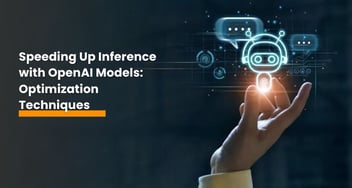Optimizing OpenAI Language Models: Strategies for Model Size Reduction
Unlock OpenAI's language model potential. Overcome size hurdles with pruning, quantization, and distillation. Explore implementation steps and optimizations. Make AI models practical across diverse applications. Optimize, transform, and elevate your AI experience!

OpenAI's language models, such as GPT-3 and its successors, have brought about a revolution in natural language understanding. OpenAI's language models development solutions find versatile applications across various business sectors, revolutionizing operations and enhancing efficiency.
However, these models are often large and resource-intensive, which can present challenges when it comes to deployment in real-world applications.
In this article, we will delve into the technical aspects of reducing the size of OpenAI language models through compression techniques, making them more practical and efficient for various applications.
The Need for Model Size Reduction
Large language models are powerful, but their size can be a hindrance in many scenarios:
1. Resource Constraints: Deploying and serving large models requires substantial computational resources, which can be cost-prohibitive.
2. Latency: In real-time applications, such as chatbots and voice assistants, the delay caused by loading and processing large models can lead to poor user experiences.
3. Deployment: Mobile devices, edge computing, and embedded systems often have limited storage and memory, making it challenging to accommodate large models.
Compression Techniques
Several techniques can be applied to reduce the size of OpenAI language models while preserving their performance and functionality:
1. Pruning
Pruning involves removing specific neurons, weights, or even entire subnetworks from the model. These components are identified based on their low contribution to the model's accuracy. Pruning is an effective way to reduce the model's size without significant loss of performance.
2. Quantization
Quantization involves reducing the precision of the model's weights and activations. Floating-point values are converted to lower-precision data types, such as 16-bit or 8-bit integers. This reduces the memory footprint of the model while still maintaining reasonable accuracy.
3. Knowledge Distillation
Knowledge distillation is a process where a smaller model, often referred to as a "student," is trained to mimic the behavior of a larger model, the "teacher." The student model learns from the teacher model's predictions, which helps it achieve similar performance with a reduced model size.
4. Model Architecture Optimization
Optimizing the architecture of the model itself can lead to size reduction. This may involve reducing the number of layers, using smaller embeddings, or adopting more efficient variants of the original model architecture.
5. Pruned Embeddings
Pruning word embeddings can significantly reduce model size. Infrequently used or low-importance embeddings can be removed or replaced with smaller representations.
6. Knowledge Retention
When applying compression techniques, it's crucial to strike a balance between size reduction and knowledge retention. Carefully choose the compression method and parameters to ensure that the model retains its ability to generate accurate and coherent language.
Development and Implementation
Implementing model size reduction techniques for OpenAI language models involves the following steps:
1. Pruning and Quantization
These techniques often require fine-tuning the model after pruning or quantization. Frameworks like TensorFlow and PyTorch provide tools for quantization-aware training, allowing you to train the model to adapt to lower-precision data types.
2. Knowledge Distillation
Train a smaller model (the student) to mimic the behavior of the original model (the teacher) using knowledge distillation techniques. Fine-tune the student model to match the teacher's predictions on a selected dataset.
3. Model Architecture Optimization
Experiment with different model architectures and hyperparameters to find a balance between size reduction and performance. Consider using model distillation to transfer knowledge from a larger model to a smaller one with a more optimized architecture.
4. Pruned Embeddings
Identify and prune word embeddings that contribute minimally to the model's performance. Ensure that the vocabulary remains sufficient for the intended use case.
Considerations
When reducing the size of OpenAI language models, consider the following:
1. Task-specific Optimization: The optimization techniques applied should align with the specific task the model is designed for. Some techniques may be more effective for certain tasks than others.
2. Fine-tuning: After applying compression techniques, it's essential to fine-tune the model to ensure it retains its language generation capabilities.
3. Performance Trade-offs: Reducing model size may lead to a slight reduction in performance. Carefully evaluate the trade-offs between model size and performance for your use case.
4. Compatibility: Ensure that the compressed model remains compatible with your deployment environment and any external libraries or APIs used in your application.
Conclusion
Reducing the size of OpenAI large language models is a crucial step towards making these powerful models more accessible and practical for a wide range of applications.
Techniques such as pruning, quantization, knowledge distillation, and model architecture optimization enable developers to strike a balance between model size and performance.
Ready to Explore OpenAI Solutions?
Get custom solutions, recommendations, estimates, confidentiality & same day response guaranteed!
As AI models continue to advance, optimizing their size will become increasingly important for deployment in resource-constrained environments, including mobile devices, edge computing, and embedded systems.
By applying these compression techniques thoughtfully and considering the specific requirements of your application, you can harness the capabilities of OpenAI large language models while mitigating the challenges associated with their size.


%201-1.webp?width=148&height=74&name=our%20work%20(2)%201-1.webp)


.png?width=344&height=101&name=Mask%20group%20(5).png)








%20with%20OpenAI%20Language%20Models.png?width=352&name=Robotics%20Process%20Automation%20(RPA)%20with%20OpenAI%20Language%20Models.png)







